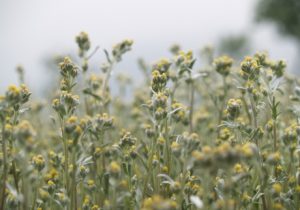
Name
Genepì Occitan
Seal of quality

Prodotto Agroalimentare Tradizionale (PAT) / Typical food-farming product.
Description
The plant
Genepì belongs botanically to the “Artemisia”, which numbers over 200 species of this plant; Artemisia genipì and Artemisia mutellina are two of the most acclaimed species used for the production of Genepì.
Artemisia genipì , also known as black Genepì, is a hairy perennial plant, of a silky grey colour, 5- 20 cm high, with aromatic characteristics in all its parts, in particular in its seeds. Flowering takes place from July to September. Its most important characteristic is the close disposition of the various heads on the flower stalk, which give the inflorescence a spike-like aspect.
Artemisia mutellina , known also as white Genepì, is a tufted perennial plant, of a silky white colour, average height 15 cm , with a wonderful aromatic fragrance in all its air parts; its properties are similar to those of Artemisia genepì . It is characterised by the production of numerous flower stalks, central vertical ones, and peripheral ones bent downwards. Its small flower heads grow along the central scape by means of stalks.
Both species grow spontaneously on the Piedmontese Alps at very high altitudes and in places very difficult to reach, between rocks, rock fall material and gravel. The difficulty in reaching these places where they grow naturally, is that picking is banned or the yield is limited, and this is what induced some mountain people, starting from the 60s, to cultivate varieties of Artemisia mutellina at much higher altitudes; these people have acquired a genuine specialisation in this difficult culture which takes time and long-term efforts.
The liqueur
Once dried, Genepì flowers are used for the production of the liqueur that is named after it, which has healing and restorative properties and is a mountain symbol par excellence. Extraction of the plant’s active ingredients can be carried out by means of infusion or suspension. In the first case, the Genepì plants are left in infusion in hydroalcoholic solutions for 40 – 45 days. The infusion thus obtained is pressed with a mixture of water and sugar in order to reduce its alcoholic content. The liqueur obtained is left to age to obtain the spontaneous sedimentation of the insoluble parts, which are then separated by means of various filtrations until the perfect vividness of the product is reached. The liqueur is a natural straw-yellow colour tending towards pale green, with an alcohol content that ranges from 30 to 42% vol. After filtration, and before being bottled, it undergoes further again.
In the suspension case, the small Genepì plants are not immersed in a hydroalcoholic solution, but are placed on special racks that are suspended above the solution itself; everything takes place in airtight containers so that, while evaporating, the alcohol extracts only the aromatic elements of the plant and not the colouring compounds. Following suspension, the sugar/water solution is added. This is a very long procedure, in fact suspension lasts at least 90 days; furthermore, the finished liqueur needs 100 – 150 days of again. Using this method, the finished product is colourless, and the alcohol content ranges from 30 to 42% vol.
Area of production
Occitan Genepì is gathered, grown and processed in the Province of Cuneo in the areas of Valle Varaita, Valle Maira, Valle Grana, Valle Stura, Valli Gesso, Valle Vermenagna, Valle Pesio, Valli Monregalesi, Valle Po,Valle Bronda ed Infernotto, Alta Valle Tanaro and in the provincia of Turin in the area of Alta Valle di Susa, Val Chisone, Val Germanasca and Val Pellice.
History
The mountain people of the Piedmontese Occitan Valleys have been preparing a restorative and agreeably digestive liqueur for centuries, infusing the Genepì plants that nature offers spontaneously. The production of this traditional liqueur dates back only as far as the 19 th century, when workshops and the first distilleries began to produce Genepì liqueur, using the spontaneous herb supplied by the valley-dwelling pickers. In the valleys of Pinerolo in particular, in the middle of the 18 th century, a notary, Giovanni Stefano Pin, was the first to introduce distillation and the alcoholic beverage in Val Chisone. He dedicated his free time to gathering and distilling the herbs. The first distillery was founded in 1823 in Finestrelle in the Cottian Alps by his nephew Stefano Pin who was specialised in the production of mountain liqueurs obtained by the infusion and distillation of flowers, aromatic herbs and mountain roots gathered in the mountains of Alta Val Chisone.
In Piedmont, the cultivation of Genepì began in the 60’s in the valleys of the provinces of Cuneo and Turin , in order to satisfy a significant increase in demand for the liqueur and to face the greater and greater difficulties in finding spontaneous Genepì.
2002 saw the foundation of the “Associazione per la Tutela e la Valorizzazione del Genepì delle Valli Occitane Piemontesi”, thanks to the support of the Regione Piemonte, through the Assessorato alla Montagna (Mountain Department), with the objective of protecting one of the most traditional products of our mountain culture. The name Genepì Occitan, which characterises the Association, wants to give this association specific importance and precise geographic value, in order to introduce, preserve and protect the liqueur produced, by continuing to follow the traditional production methods, distinguishing it from the other liqueur present on the market, which is similar but not authentic.